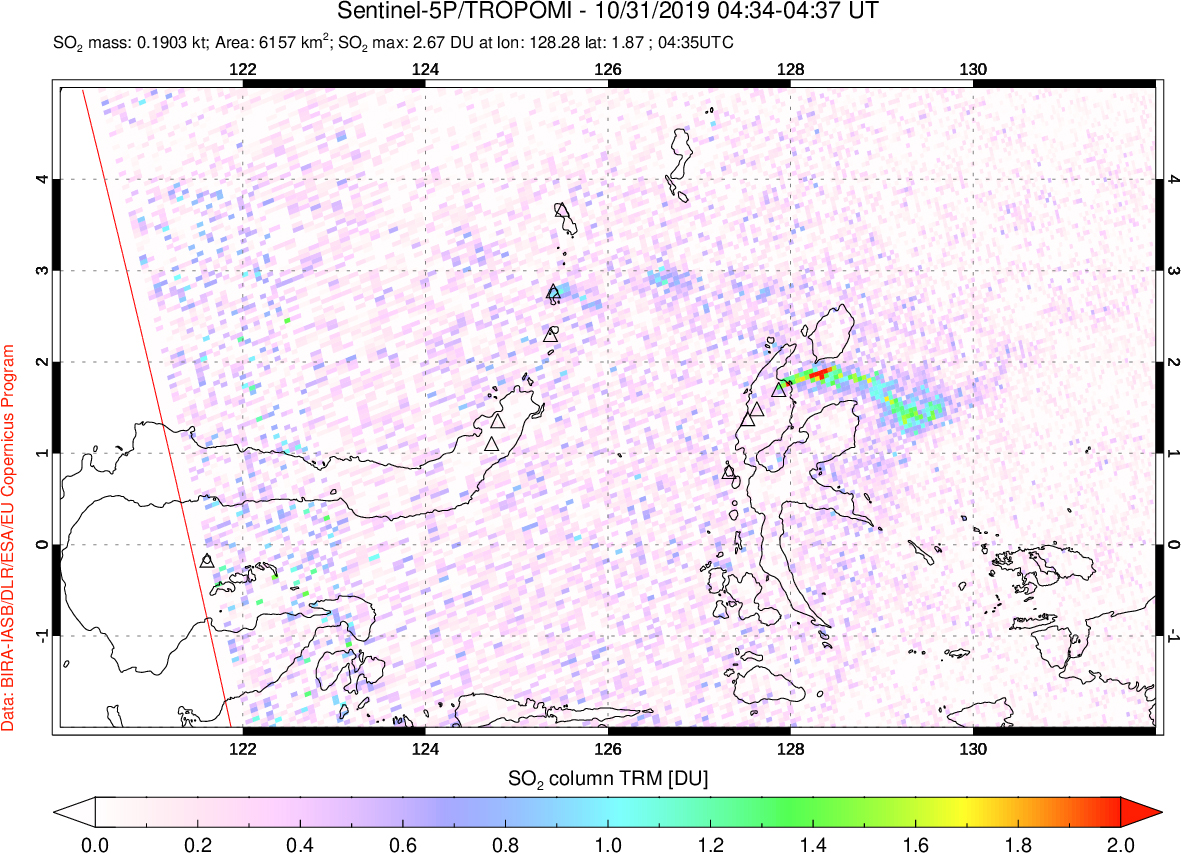Report on Dukono (Indonesia) — May 2020
Bulletin of the Global Volcanism Network, vol. 45, no. 5 (May 2020)
Managing Editor: Edward Venzke.
Research and preparation by Paul Berger.
Dukono (Indonesia) Numerous ash explosions continue through March 2020
Please cite this report as:
Global Volcanism Program, 2020. Report on Dukono (Indonesia) (Venzke, E., ed.). Bulletin of the Global Volcanism Network, 45:5. Smithsonian Institution. https://doi.org/10.5479/si.GVP.BGVN202005-268010
Dukono
Indonesia
1.6992°N, 127.8783°E; summit elev. 1273 m
All times are local (unless otherwise noted)
The ongoing eruption at Dukono is characterized by frequent explosions that send ash plumes to about 1.5-3 km altitude (0.3-1.8 km above the summit), although a few have risen higher. This type of typical activity (figure 13) continued through at least March 2020. The ash plume data below (table 21) were primarily provided by the Pusat Vulkanologi dan Mitigasi Bencana Geologi (PVMBG) and the Darwin Volcanic Ash Advisory Centre (VAAC). During the reporting period of October 2019-March 2020, the Alert Level remained at 2 (on a scale of 1-4) and the public was warned to remain outside of the 2-km exclusion zone.
Table 21. Monthly summary of reported ash plumes from Dukono for October 2019-March 2020. The direction of drift for the ash plume through each month was highly variable; notable plume drift each month was only indicated in the table if at least two weekly reports were consistent. Data courtesy of the Darwin VAAC and PVMBG.
| Month | Plume Altitude (km) | Notable Plume Drift |
| Oct 2019 | 1.8-3 | Multiple |
| Nov 2019 | 1.8-2.3 | E, SE, NE |
| Dec 2019 | 1.8-2.1 | E, SE |
| Jan 2020 | 1.8-2.1 | E, SE, SW, S |
| Feb 2020 | 2.1-2.4 | S, SW |
| Mar 2020 | 1.5-2.3 | Multiple |
 |
Figure 13.Satellite image of Dukono from Sentinel-2 on 12 November 2019, showing an ash plume drifting E. Image uses natural color rendering (bands 4, 3, 2). Courtesy of Sentinel Hub Playground. |
During the reporting period, high levels of sulfur dioxide were only recorded above or near the volcano during 30-31 October and 4 November 2019. High levels were recorded by the Ozone Mapping and Profiler Suite (OMPS) instrument aboard the Suomi National Polar-orbiting Partnership (NPP) satellite on 30 October 2019, in a plume drifting E. The next day high levels were also recorded by the TROPOspheric Monitoring Instrument (TROPOMI) aboard the Copernicus Sentinel-5 Precursor satellite on 31 October (figure 14) and 4 November 2019, in plumes drifting SE and NE, respectively.
Geological Summary. Reports from this remote volcano in northernmost Halmahera are rare, but Dukono has been one of Indonesia's most active volcanoes. More-or-less continuous explosive eruptions, sometimes accompanied by lava flows, have occurred since 1933. During a major eruption in 1550 CE, a lava flow filled in the strait between Halmahera and the N-flank Gunung Mamuya cone. This complex volcano presents a broad, low profile with multiple summit peaks and overlapping craters. Malupang Wariang, 1 km SW of the summit crater complex, contains a 700 x 570 m crater that has also been active during historical time.
Information Contacts: Pusat Vulkanologi dan Mitigasi Bencana Geologi (PVMBG, also known as Indonesian Center for Volcanology and Geological Hazard Mitigation, CVGHM), Jalan Diponegoro 57, Bandung 40122, Indonesia (URL: http://www.vsi.esdm.go.id/); Darwin Volcanic Ash Advisory Centre (VAAC), Bureau of Meteorology, Northern Territory Regional Office, PO Box 40050, Casuarina, NT 0811, Australia (URL: http://www.bom.gov.au/info/vaac/); Global Sulfur Dioxide Monitoring Page, Atmospheric Chemistry and Dynamics Laboratory, NASA Goddard Space Flight Center (NASA/GSFC), 8800 Greenbelt Road, Goddard, Maryland, USA (URL: https://so2.gsfc.nasa.gov/); Sentinel Hub Playground (URL: https://www.sentinel-hub.com/explore/sentinel-playground).


